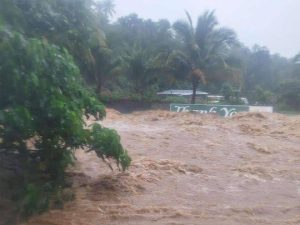Digital News Desk:
Typhoon Kristine, currently affecting the Philippines, has prompted the government to place seven regions under the highest level of emergency preparedness. Kristine, categorized as a powerful typhoon, has brought heavy rains, strong winds, and potential flooding across central and northern parts of the country, raising concerns about landslides and storm surges in coastal communities.
Impact on Regions
The regions under heightened alert include provinces in Luzon and Visayas, where evacuation orders are in place for those in high-risk areas. The government has mobilized resources, including emergency teams and relief goods, to address the immediate needs of affected populations. Local governments have also set up evacuation centers in anticipation of the storm’s worst effects. Schools and government offices in the affected areas have been closed, while transport services have been disrupted.
Kristine is following a path similar to previous destructive storms in the region, intensifying worries as it gains strength. With its landfall expected soon, residents are bracing for the potential destruction it could cause, especially in areas still recovering from earlier typhoons. The national disaster risk reduction agencies have urged the public to stay informed through official channels and to take necessary precautions.
Typhoon Kristine’s Meteorological Data
As of the latest reports, Typhoon Kristine is packing sustained winds of over 150 kilometers per hour (93 mph) near the center, with gusts reaching up to 185 kph (115 mph). It has been gradually intensifying as it moves across the Pacific toward the Philippines. The typhoon’s diameter spans several hundred kilometers, which means widespread heavy rainfall is expected even in areas far from the center.
The Philippine Atmospheric, Geophysical and Astronomical Services Administration (PAGASA) has issued the highest storm warnings in several provinces, including Signal No. 4 alerts in the direct path of the storm. PAGASA has also warned of intense rainfall, with projections indicating up to 300 millimeters (12 inches) of rain in some areas over the next 48 hours. The storm is expected to weaken slightly as it crosses over land, but its residual effects—such as flooding and strong winds—will likely linger for several days.

Humanitarian Efforts and Government Response
The National Disaster Risk Reduction and Management Council (NDRRMC) is working in coordination with local governments to ensure preparedness. Relief operations are being coordinated to support communities at risk, including pre-positioning food supplies, clean water, and medical assistance in potential disaster zones. Power outages are expected, and utility companies are preparing to restore services as quickly as possible after the storm.
Philippine President Ferdinand Marcos Jr. has called for all national and local agencies to work together to minimize the loss of life and property. Marcos stressed the importance of proactive evacuations, especially in low-lying coastal towns vulnerable to storm surges. These surges, which are large waves caused by the storm’s powerful winds, could inundate homes and infrastructure, posing significant risks to lives and livelihoods.
International humanitarian organizations, including the Red Cross, are also on standby to assist with relief efforts. Neighboring countries in Southeast Asia are closely monitoring the situation, with some already offering emergency assistance if needed. The Philippines has long been a hotspot for typhoons, and with climate change exacerbating the intensity of these storms, preparation and international cooperation have become even more critical.
Previous Typhoon Impact and Climate Change Concerns
The Philippines regularly faces an average of 20 typhoons annually, and some, like 2013’s Typhoon Haiyan, have caused catastrophic damage. In recent years, experts have noted that climate change is making storms stronger and more unpredictable. Rising sea temperatures in the Pacific Ocean provide more energy for storms, resulting in increased wind speeds and more rainfall.
As Typhoon Kristine makes landfall, these concerns resurface. Climate scientists and local environmentalists have urged the government to strengthen long-term infrastructure resilience and disaster preparedness. Coastal areas, which are home to millions of Filipinos, are particularly vulnerable to stronger typhoons and rising sea levels. Recent typhoons have also highlighted the need for more robust disaster risk reduction strategies, especially in marginalized communities with limited access to resources.
Current Situation and What’s Next
The next 24 to 48 hours will be critical as Typhoon Kristine makes its impact. Residents are urged to stay indoors, evacuate if necessary, and monitor official announcements for updates. Although the storm is expected to weaken slightly after landfall, the aftermath could still bring severe flooding, landslides, and prolonged disruptions in essential services.
The Philippine government’s response will continue to evolve as the situation develops, with a focus on immediate rescue operations and long-term recovery efforts. The international community will also likely play a role in supporting the country, as it has done during previous typhoon disasters.
In the wake of Typhoon Kristine, the focus will shift to rebuilding and recovery, but the event serves as another reminder of the growing threat that climate change poses to vulnerable regions like the Philippines.
You May Also Read: Ayodhya’s 2024 Diwali: Grand Diwali Preparations and Ram Lalla Temple Highlight








